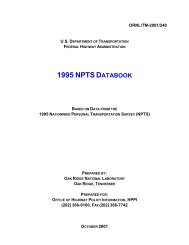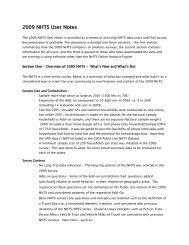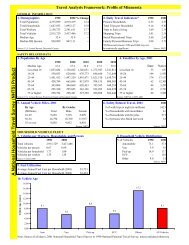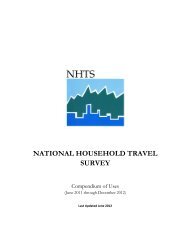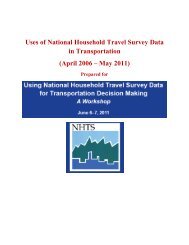- Page 1 and 2: 2001 NATIONAL HOUSEHOLD TRAVEL SURV
- Page 3 and 4: TABLE OF CONTENTS (continued) 2-D.8
- Page 5 and 6: TABLE OF CONTENTS (continued) 6-C.
- Page 7 and 8: TABLE OF CONTENTS (continued) LIST
- Page 9 and 10: USER’S GUIDE This guide includes
- Page 11 and 12: These data are collected for: • a
- Page 13 and 14: • information on each household v
- Page 15 and 16: 1.C.2. WHEN WAS THE SURVEY CONDUCTE
- Page 17 and 18: Exhibit 1-1. Changes Over Time in t
- Page 19: The 1969 questionnaire was very sho
- Page 23 and 24: CHAPTER 2. SURVEY CONTENT AND INTER
- Page 25 and 26: As in the Wisconsin add-on, the adv
- Page 27 and 28: Exhibit 2-1. Household Interview Co
- Page 29 and 30: • the interviewer was told that t
- Page 31 and 32: Exhibit 2-2. Person Interview Conte
- Page 33 and 34: Exhibit 2-3. Contents of the Odomet
- Page 35 and 36: 5. Driver status - items C8, C13 an
- Page 37 and 38: 6. Overnight stops, transportation
- Page 39 and 40: include additional questions to det
- Page 41 and 42: 2-E. TYPICAL NHTS HOUSEHOLD 2-E.1.
- Page 43 and 44: Person Interview - Amy completed he
- Page 45 and 46: Person Interview continued with Amy
- Page 47 and 48: 2-E.7. TYPICAL NHTS HOUSEHOLD: THAN
- Page 49 and 50: 3-A.2. HOW THE DATA WERE COLLECTED
- Page 51 and 52: 3-B.2. SAMPLING FRAME Westat’s sa
- Page 53 and 54: 3-C.3. INTERVIEWER MONITORING Inter
- Page 55 and 56: 3-C.8. ADVANCE LETTER AND CASH INCE
- Page 57 and 58: • An eye-catching bright yellow r
- Page 59 and 60: • if a travel diary was completed
- Page 61 and 62: 3-D.2. UPDATING CATI DURING DATA CO
- Page 63 and 64: 3-D.3. APPROACH TO POST INTERVIEW E
- Page 65 and 66: thus were recorded on a "Missed Tri
- Page 67 and 68: In addition to missed trips reporte
- Page 69 and 70: member at all times on the trip. If
- Page 71 and 72:
Table 3-1. Number of Completed Hous
- Page 73 and 74:
8. During the editing process, cert
- Page 75 and 76:
Exhibit 3-1. Changes in the 2001 NH
- Page 77 and 78:
CHAPTER 4. SURVEY RESPONSE RATES We
- Page 79 and 80:
Table 4-1. Weighted Household Respo
- Page 81 and 82:
Table 4-2. Weighted Person Response
- Page 83 and 84:
5-A. HOUSEHOLD WEIGHTS 5-A.1. INITI
- Page 85 and 86:
A final step was to “trim” very
- Page 87 and 88:
5-C. PERSON TRIP WEIGHTS FOR TRAVEL
- Page 89 and 90:
CHAPTER 6. DESCRIPTION OF DATA FILE
- Page 91 and 92:
6-B. RELATIONSHIP BETWEEN THE FOUR
- Page 93 and 94:
In earlier NHTSs, before “stayed
- Page 95 and 96:
Exhibit 6-2. Contents of the 2001 N
- Page 97 and 98:
NQR (No match with 1995) Indicates
- Page 99 and 100:
6-E. DERIVED VARIABLES Over 239 der
- Page 101 and 102:
7-A. TRAVEL CONCEPTS 7-A.1. OVERVIE
- Page 103 and 104:
Contact information for user suppor
- Page 105 and 106:
7-D.2. WHICH WEIGHT TO USE There ar
- Page 107 and 108:
Tables 7-2 and 7-3 provide the vari
- Page 109 and 110:
vehicles that would have been obtai
- Page 111 and 112:
7-G.2. ID NUMBERS Each unit (e.g. h
- Page 113 and 114:
The variables HOUSEID and PERSONID
- Page 115 and 116:
NHTS Listing of All Variables By Al
- Page 117 and 118:
NHTS Listing of All Variables By Al
- Page 119 and 120:
NHTS Listing of All Variables By Al
- Page 121 and 122:
NHTS Listing of All Variables By Al
- Page 123 and 124:
NHTS Listing of All Variables By Al
- Page 125 and 126:
NHTS Listing of All Variables By Al
- Page 127 and 128:
NHTS Listing of All Variables By Al
- Page 129 and 130:
NHTS Listing of All Variables By Al
- Page 131 and 132:
NHTS Listing of All Variables By Al
- Page 133 and 134:
NHTS Household File Codebook Public
- Page 135 and 136:
NHTS Household File Codebook Public
- Page 137 and 138:
NHTS Household File Codebook Public
- Page 139 and 140:
NHTS Household File Codebook Public
- Page 141 and 142:
NHTS Household File Codebook Public
- Page 143 and 144:
NHTS Household File Codebook Public
- Page 145 and 146:
NHTS Household File Codebook Public
- Page 147 and 148:
NHTS Household File Codebook Public
- Page 149 and 150:
NHTS Household File Codebook Public
- Page 151 and 152:
NHTS Household File Codebook Public
- Page 153 and 154:
NHTS Household File Codebook Public
- Page 155 and 156:
NHTS Household File Codebook Public
- Page 157 and 158:
NHTS Household File Codebook Public
- Page 159 and 160:
NHTS Household File Codebook Public
- Page 161 and 162:
NHTS Household File Codebook Public
- Page 163 and 164:
NHTS Household File Codebook Public
- Page 165 and 166:
NHTS Household File Codebook Public
- Page 167 and 168:
NHTS Household File Codebook Public
- Page 169 and 170:
NHTS Household File Codebook Public
- Page 171 and 172:
NHTS Person File Codebook Public Us
- Page 173 and 174:
NHTS Person File Codebook Public Us
- Page 175 and 176:
NHTS Person File Codebook Public Us
- Page 177 and 178:
NHTS Person File Codebook Public Us
- Page 179 and 180:
NHTS Person File Codebook Public Us
- Page 181 and 182:
NHTS Person File Codebook Public Us
- Page 183 and 184:
NHTS Person File Codebook Public Us
- Page 185 and 186:
NHTS Person File Codebook Public Us
- Page 187 and 188:
NHTS Person File Codebook Public Us
- Page 189 and 190:
NHTS Person File Codebook Public Us
- Page 191 and 192:
NHTS Person File Codebook Public Us
- Page 193 and 194:
NHTS Person File Codebook Public Us
- Page 195 and 196:
NHTS Person File Codebook Public Us
- Page 197 and 198:
NHTS Person File Codebook Public Us
- Page 199 and 200:
NHTS Person File Codebook Public Us
- Page 201 and 202:
NHTS Person File Codebook Public Us
- Page 203 and 204:
NHTS Person File Codebook Public Us
- Page 205 and 206:
NHTS Person File Codebook Public Us
- Page 207 and 208:
NHTS Person File Codebook Public Us
- Page 209 and 210:
NHTS Vehicle File Codebook Public U
- Page 211 and 212:
NHTS Vehicle File Codebook Public U
- Page 213 and 214:
NHTS Vehicle File Codebook Public U
- Page 215 and 216:
NHTS Vehicle File Codebook Public U
- Page 217 and 218:
NHTS Vehicle File Codebook Public U
- Page 219 and 220:
NHTS Vehicle File Codebook Public U
- Page 221 and 222:
NHTS Vehicle File Codebook Public U
- Page 223 and 224:
NHTS Vehicle File Codebook Public U
- Page 225 and 226:
NHTS Vehicle File Codebook Public U
- Page 227 and 228:
NHTS Vehicle File Codebook Public U
- Page 229 and 230:
NHTS Vehicle File Codebook Public U
- Page 231 and 232:
NHTS Vehicle File Codebook Public U
- Page 233 and 234:
NHTS Vehicle File Codebook Public U
- Page 235 and 236:
NHTS Vehicle File Codebook Public U
- Page 237 and 238:
NHTS Day Trip File Codebook Public
- Page 239 and 240:
NHTS Day Trip File Codebook Public
- Page 241 and 242:
NHTS Day Trip File Codebook Public
- Page 243 and 244:
NHTS Day Trip File Codebook Public
- Page 245 and 246:
NHTS Day Trip File Codebook Public
- Page 247 and 248:
NHTS Day Trip File Codebook Public
- Page 249 and 250:
NHTS Day Trip File Codebook Public
- Page 251 and 252:
NHTS Day Trip File Codebook Public
- Page 253 and 254:
NHTS Day Trip File Codebook Public
- Page 255 and 256:
NHTS Day Trip File Codebook Public
- Page 257 and 258:
NHTS Day Trip File Codebook Public
- Page 259 and 260:
NHTS Day Trip File Codebook Public
- Page 261 and 262:
NHTS Day Trip File Codebook Public
- Page 263 and 264:
NHTS Day Trip File Codebook Public
- Page 265 and 266:
NHTS Day Trip File Codebook Public
- Page 267 and 268:
NHTS Day Trip File Codebook Public
- Page 269 and 270:
NHTS Day Trip File Codebook Public
- Page 271 and 272:
NHTS Day Trip File Codebook Public
- Page 273 and 274:
NHTS Day Trip File Codebook Public
- Page 275 and 276:
NHTS Long Trip File Codebook Public
- Page 277 and 278:
NHTS Long Trip File Codebook Public
- Page 279 and 280:
NHTS Long Trip File Codebook Public
- Page 281 and 282:
NHTS Long Trip File Codebook Public
- Page 283 and 284:
NHTS Long Trip File Codebook Public
- Page 285 and 286:
NHTS Long Trip File Codebook Public
- Page 287 and 288:
NHTS Long Trip File Codebook Public
- Page 289 and 290:
NHTS Long Trip File Codebook Public
- Page 291 and 292:
NHTS Long Trip File Codebook Public
- Page 293 and 294:
NHTS Long Trip File Codebook Public
- Page 295 and 296:
NHTS Long Trip File Codebook Public
- Page 297 and 298:
NHTS Long Trip File Codebook Public
- Page 299 and 300:
NHTS Long Trip File Codebook Public
- Page 301 and 302:
NHTS Long Trip File Codebook Public
- Page 303 and 304:
NHTS Long Trip File Codebook Public
- Page 305 and 306:
NHTS Long Trip File Codebook Public
- Page 307 and 308:
NHTS Long Trip File Codebook Public
- Page 309 and 310:
NHTS Long Trip File Codebook Public
- Page 311 and 312:
NHTS Long Trip File Codebook Public
- Page 313 and 314:
NHTS Long Trip File Codebook Public
- Page 315 and 316:
NHTS Long Trip File Codebook Public
- Page 317 and 318:
NHTS Long Trip File Codebook Public
- Page 319 and 320:
NHTS Long Trip File Codebook Public
- Page 321 and 322:
NHTS Long Trip File Codebook Public
- Page 323 and 324:
The SAS System 2001-2002 National H
- Page 325 and 326:
The SAS System 2001-2002 National H
- Page 327 and 328:
The SAS System 2001-2002 National H
- Page 329 and 330:
The SAS System 2001-2002 National H
- Page 331 and 332:
The SAS System 2001-2002 National H
- Page 333 and 334:
The SAS System 2001-2002 National H
- Page 335 and 336:
The SAS System 2001-2002 National H
- Page 337 and 338:
The SAS System 2001-2002 National H
- Page 339 and 340:
The SAS System 2001-2002 National H
- Page 341 and 342:
The SAS System 2001-2002 National H
- Page 343 and 344:
The SAS System 2001-2002 National H
- Page 345 and 346:
The SAS System 2001-2002 National H
- Page 347 and 348:
APPENDIX D DERIVED VARIABLES This a
- Page 349 and 350:
year. Provided by EIA. 14. CDIVMSAR
- Page 351 and 352:
31. DRVR_P1 to DRVR_P14*: Indicates
- Page 353 and 354:
59. GSCOST: Fuel cost estimated in
- Page 355 and 356:
05 Variable HH_RACE5 (C7) is yes (N
- Page 357 and 358:
104. IMPTAGE: Subject's age (AGE (C
- Page 359 and 360:
16-21 group. 4. If household member
- Page 361 and 362:
133. NBIKETRP*: The variable was ob
- Page 363 and 364:
calls to the household. Deliver in
- Page 365 and 366:
11, 2001. Derived from variable TDA
- Page 367 and 368:
201. VEHOWNMO: How long the vehicle
- Page 369 and 370:
220. WKSTFIPS: State FIPS Code for
- Page 371 and 372:
APPENDIX E ABBREVIATIONS, TRAVEL CO
- Page 373 and 374:
egardless of the number of persons
- Page 375 and 376:
GLOSSARY HOW TO COMPUTE - The four
- Page 377 and 378:
Employed A person is considered emp
- Page 379 and 380:
4. Pickup Truck. A pickup truck is
- Page 381 and 382:
Passenger For a specific trip, a pa
- Page 383 and 384:
or to participate in a sport. 17. R
- Page 385 and 386:
Worker See “Employed”. 1. Autom
- Page 387 and 388:
Table 1. Full Sample Household Cont
- Page 389 and 390:
Table 1. Full Sample Household Cont
- Page 391 and 392:
Table 1. Full Sample Household Cont
- Page 393 and 394:
Table 1. Full Sample Household Cont
- Page 395 and 396:
Table 1. Full Sample Household Cont
- Page 397 and 398:
Table 2. Full Sample Person Control
- Page 399 and 400:
Table 2. Full Sample Person Control
- Page 401 and 402:
Table 2. Full Sample Person Control
- Page 403 and 404:
Table 2. Full Sample Person Control
- Page 405 and 406:
Table 2. Full Sample Person Control
- Page 407 and 408:
Table 2. Full Sample Person Control
- Page 409 and 410:
Table 2. Full Sample Person Control
- Page 411 and 412:
Table 3. National Sample Household
- Page 413 and 414:
Table 3. National Sample Household
- Page 415 and 416:
Table 3. National Sample Household
- Page 417 and 418:
Table 3. National Sample Household
- Page 419 and 420:
Table 4. National Sample Person Con
- Page 421 and 422:
Table 4. National Sample Person Con
- Page 423 and 424:
Table 4. National Sample Person Con
- Page 425 and 426:
Table 4. National Sample Person Con
- Page 427 and 428:
Table 5. Control Totals for Checkin
- Page 429 and 430:
APPENDIX G STANDARD TABLES AND LOGI
- Page 431 and 432:
Table 1: Number of Households, By F
- Page 433 and 434:
Table 3: Number of Persons in House
- Page 435 and 436:
Table 4: Number of Drivers, by Annu
- Page 437 and 438:
Table 5: Number of Workers, By MSA
- Page 439 and 440:
Table 7: Average Number of Travel D
- Page 441 and 442:
Table 9: Number of Travel Day Vehic
- Page 443 and 444:
Table 12: Average Vehicle Occupancy
- Page 445 and 446:
2 = Median Home Value between Q1 an
- Page 447 and 448:
Household Size (1, 2, 3, 4 or more)
- Page 449 and 450:
H-2. VARIABLES USED TO DEFINE NONRE
- Page 451 and 452:
Home Ownership - (Owner/Renter) - H
- Page 453 and 454:
• Numbers that are in-scope. Tele
- Page 455 and 456:
Survey Research Organizations (CASR
- Page 457 and 458:
identical to the person interview c
- Page 459 and 460:
Table I-4. Classification of Househ
- Page 461 and 462:
useable household person interview
- Page 463 and 464:
APPENDIX J METHODS TO ESTIMATE ANNU
- Page 465 and 466:
Table J-1. Lag Time between Two Odo
- Page 467 and 468:
Table J-2. 2001 NHTS Sample Vehicle
- Page 469 and 470:
Table J-3. NHTS Vehicles 1 by Data
- Page 471 and 472:
Odometer2 − Odometer1 VMTJuly2001
- Page 473 and 474:
these 48 percentages was used as a
- Page 475 and 476:
J-5. ESTIMATION METHODS Six differe
- Page 477 and 478:
Approach 3. For vehicles with self-
- Page 479 and 480:
J-6. SCREENING OF BESTMILE ESTIMATE
- Page 481 and 482:
Consistently to the data quality ch
- Page 483 and 484:
APPENDIX K ESTIMATION METHODOLOGIES
- Page 485 and 486:
The estimation of these statistics
- Page 487 and 488:
adequacy of shortfall adjustments h
- Page 489 and 490:
MPG(EPA 55/45) denotes the composit
- Page 491 and 492:
MPG MPG i(on i(on - road, EPA city)
- Page 493 and 494:
household is in the South, otherwis
- Page 495 and 496:
m mpg c ij = ij , ∀ j = 1, 2, …
- Page 497 and 498:
expenditures, Ei, was estimated by
- Page 499 and 500:
January 2004 Version were set to
- Page 501 and 502:
Table 3. Number of Vehicles, Vehicl
- Page 503 and 504:
Table 4. United States per Vehicle-
- Page 505 and 506:
Peugeot 44 H-42 Lada 69 H-56 Porsch
- Page 507 and 508:
MAKE: Alfa Romeo (Cont.) (31) (ALFA
- Page 509 and 510:
MAKE: Audi (Cont.) (32) (AUDI) Code
- Page 511 and 512:
MAKE: Buick (18) (BUIC) Codes AUTOM
- Page 513 and 514:
MAKE: Chevrolet (Cont.) (20) (CHEV)
- Page 515 and 516:
MAKE: Chevrolet (Cont.) (20) (CHEV)
- Page 517 and 518:
MAKE: Chrysler/DaimlerChrysler (Con
- Page 519 and 520:
MAKE: Dodge (07) (DODG) Codes Model
- Page 521 and 522:
MAKE: Eagle* (10) (EGIL) Codes AUTO
- Page 523 and 524:
MAKE: Ford (Cont.) (12) (FORD) Code
- Page 525 and 526:
MAKE: Ford (Cont.) (12) (FORD) Code
- Page 527 and 528:
MAKE: GMC (Cont.) (23) (GMC ) Codes
- Page 529 and 530:
MAKE: Honda (Acura: See “54”) (
- Page 531 and 532:
MAKE: Isuzu (Cont.) (38) (ISU ) Cod
- Page 533 and 534:
MAKE: Lancia (40) (LINCI) Codes AUT
- Page 535 and 536:
MAKE: Lincoln (Cont.) (13) (LINC) C
- Page 537 and 538:
MAKE: Mercedes Benz (Cont.) (42) (M
- Page 539 and 540:
MAKE: Mercury (Merkur: See “56”
- Page 541 and 542:
MAKE: Mitsubishi (Cont.) (52) (MITS
- Page 543 and 544:
MAKE: Oldsmobile (Cont.) (21) (OLDS
- Page 545 and 546:
MAKE: Plymouth (Cont.) (09) (PLYM)
- Page 547 and 548:
MAKE: Pontiac (Cont.) (22) (PONT) C
- Page 549 and 550:
MAKE: Saturn (24) (STrN) Codes AUTO
- Page 551 and 552:
MAKE: Suzuki (53) (SUZI) Codes MOTO
- Page 553 and 554:
MAKE: Triumph (50) (TRIU) Codes AUT
- Page 555 and 556:
MAKE: Volvo (51) (VOLVO) Codes AUTO
- Page 557 and 558:
MAKE: Other Import (69) Codes AUTOM
- Page 559 and 560:
MAKE: BSA (70) (BSA ) Codes Model I
- Page 561 and 562:
Codes Model Includes Model Years Bo
- Page 563 and 564:
MAKE: Freightliner (Cont.) (82) (FR
- Page 565 and 566:
MAKE: International Harvester/ Navi
- Page 567 and 568:
MAKE: Iveco/Magirus* (Cont.) (88) (
- Page 569 and 570:
MAKE: Gillig (92) Codes Model Inclu
- Page 571 and 572:
MAKE: Other Make (Cont.) (98) Codes
- Page 573 and 574:
APPENDIX M 2001 NHTS QUESTIONNAIRE
- Page 575 and 576:
SECTION B: VEHICLE DATA PROGRAMMER
- Page 577 and 578:
PROGRAMMER NOTE: SET SCRN.VEHICNT.
- Page 579 and 580:
C3. (C8) Including yourself, how ma
- Page 581 and 582:
PROGRAMMER NOTE: DO NOT ALLOW SCRES
- Page 583 and 584:
C10. (SC20) Going back to the ages
- Page 585 and 586:
IF OTHRPHON = 0, GO TO BOX BEFORE D
- Page 587 and 588:
D3. (D4) To whom should we address
- Page 589 and 590:
D8. (D6) Travel patterns are affect
- Page 591 and 592:
NATIONAL HOUSEHOLD TRAVEL SURVEY Te
- Page 593 and 594:
E4. (N_F1A) Last week, did {you/SUB
- Page 595 and 596:
SEGMENT WORK E10. (N_F4) Transporta
- Page 597 and 598:
E13. (N_F4B) Would you please provi
- Page 599 and 600:
E16. (N_F7) How did {you/SUBJECT} u
- Page 601 and 602:
E18. (N_F8A) How many people, inclu
- Page 603 and 604:
G4. (N_G11A) Let’s continue with
- Page 605 and 606:
PROGRAMMER NOTE: VERIFY IF PREVIOUS
- Page 607 and 608:
PROGRAMMER NOTE: START TIME FOR FIR
- Page 609 and 610:
G19. (N_G20) Did {you/SUBJECT} use
- Page 611 and 612:
G22. (MPO3) {What is the name of th
- Page 613 and 614:
G25B. (N_G212) [Now I have a few qu
- Page 615 and 616:
G26. (N_G22) {Now I have a few ques
- Page 617 and 618:
G26E. (N_G217) [Now I have a few qu
- Page 619 and 620:
G27E. (N_G217) What was {your/his/h
- Page 621 and 622:
G33. (N_G26OV) Which one? (PUBTYPE)
- Page 623 and 624:
G35. (N_G27A) How did {you/SUBJECT}
- Page 625 and 626:
G38. (N_G28A) How did {you/SUBJECT}
- Page 627 and 628:
PROGRAMMER NOTE: IF (G41 (N_G29A))
- Page 629 and 630:
G45. (N_G32) Which household member
- Page 631 and 632:
PROGRAMMER NOTE: FOR HHM ENTERED IN
- Page 633 and 634:
H1. (H2_4) {What was the farthest c
- Page 635 and 636:
SECTION I: FARTHEST TRIP DETAIL PRO
- Page 637 and 638:
I5. What type of transportation did
- Page 639 and 640:
I8. What type of transportation did
- Page 641 and 642:
I11. After {you/s(he)} arrived at t
- Page 643 and 644:
PROGRAMMER NOTE: ALLOW INTERVIEWERS
- Page 645 and 646:
I15. What type of transportation di
- Page 647 and 648:
SECTION J: OVERNIGHT STOPS ROSTERIN
- Page 649 and 650:
J3. Tell me all the types of transp
- Page 651 and 652:
PROGRAMMER NOTE: IF K2 (G2) MRTMTH
- Page 653 and 654:
K7. (T2) In what month did {you/SUB
- Page 655 and 656:
PROGRAMMER NOTE: IN L2 (N_E1A-D), A
- Page 657 and 658:
PROGRAMMER NOTE: IF L5 (N_E2) YEARM
- Page 659 and 660:
PROGRAMMER NOTE: IF THE VEHICLE IS
- Page 661 and 662:
L11. (N_E8) In the past two months,
- Page 663 and 664:
M5. (N_K5D) How long {have you/has
- Page 665 and 666:
PROGRAMMER NOTE: RANGE FOR M10 (N_K
- Page 667 and 668:
SEGMENT SCRN M13. (K6) In surveys l
- Page 669 and 670:
M22. (K15) Does this include income
- Page 671 and 672:
M28. (K21) Was {your/his/her} incom
- Page 673 and 674:
N3. (ODVERF) [RECORD THE ODOMETER M
- Page 675 and 676:
SECTION B: VEHICLE DATA BINTRO El p
- Page 677 and 678:
SECTION C: PERSON DATA FOR EACH HOU
- Page 679 and 680:
C8. (S7A THROUGH S7H ) Por favor d
- Page 681 and 682:
C16. (C5) ¿Cuántos de estos {OTHR
- Page 683 and 684:
D5. (D3) Para poder enviarle a uste
- Page 685 and 686:
D11. (D9) Le enviaremos a usted {la
- Page 687 and 688:
E3 (N_F1) Durante la mayoría de la
- Page 689 and 690:
E10. (N_F4) Quienes planean la tran
- Page 691 and 692:
E15. (N_F6) La semana pasada, ¿cu
- Page 693 and 694:
E17. (N_F8) La semana pasada, ¿{us
- Page 695 and 696:
G6. (N_G9A) ¿Anotó {usted/SUBJECT
- Page 697 and 698:
G14. (N_G17) ¿En qué fecha hizo {
- Page 699 and 700:
G22. (MPO3) {¿Cuál es el nombre d
- Page 701 and 702:
G25C. (N_G214) [Ahora tengo unas cu
- Page 703 and 704:
G26B. (N_G212) {Ahora tengo unas cu
- Page 705 and 706:
G27A. (N_G211) ¿Cuál fue la razó
- Page 707 and 708:
G31. (N_G26) ¿Cuál vehículo? (VE
- Page 709 and 710:
G35. (N_G27A) ¿De qué manera lleg
- Page 711 and 712:
G38. (N_G28A) ¿Cómo llegó {usted
- Page 713 and 714:
G44. (N_G31) ¿Había algún miembr
- Page 715 and 716:
SEGMENT - TRIP SECTION H: FARTHEST
- Page 717 and 718:
SEGMENT - TRIP SECTION I: FARTHEST
- Page 719 and 720:
I6. ¿Quién era el chofer? (¿Qui
- Page 721 and 722:
I9. ¿Cómo se llamaba el/la {aerop
- Page 723 and 724:
I12. Dígame todos los tipos de tra
- Page 725 and 726:
I15. ¿Qué tipo de transportación
- Page 727 and 728:
SEGMENT - STAY SECTION J: OVERNIGHT
- Page 729 and 730:
J3. Dígame todos los tipos de tran
- Page 731 and 732:
K4. (G3) ¿Cuál fue la ciudad y es
- Page 733 and 734:
SEGMENT GTRV SECTION L: GENERAL TRA
- Page 735 and 736:
L3. (N_E9) En la última semana, ¿
- Page 737 and 738:
L9. (N_E5) En los últimos 12 meses
- Page 739 and 740:
SEGMENT TRAV SECTION M: INTERNET US
- Page 741 and 742:
M8. (N_K5F) ¿Nació {usted/SUBJECT
- Page 743 and 744:
SEGMENT SCRN M13. (K6) En encuestas
- Page 745 and 746:
M23. (K16) ¿El ingreso de quién n
- Page 747 and 748:
SEGMENT VEHI SECTION N: COLLECTION
- Page 749 and 750:
27. Morpace: Cover letter sent with
- Page 751 and 752:
N-4
- Page 753 and 754:
N-6
- Page 755 and 756:
N-8
- Page 757 and 758:
N-10
- Page 759 and 760:
NATIONAL HOUSEHOLD TRAVEL SURVEY In
- Page 761 and 762:
ENCUESTA NACIONAL DE TRANSPORTE EN
- Page 763 and 764:
N-16
- Page 765 and 766:
NHTS 2001 Odometer Mileage Form For
- Page 767 and 768:
NHTS 2001 Odometer Mileage Form Tha
- Page 769 and 770:
ID - 14959963 PHONE: (---) ___ - __
- Page 771 and 772:
National Household Travel Survey Re
- Page 773 and 774:
16. Who was that? NATIONAL HOUSEHOL
- Page 775 and 776:
N-28 National Household Are you con
- Page 777 and 778:
Dear Participating Household: Are y
- Page 779 and 780:
Dear Kentucky Traveler: Are you con
- Page 781 and 782:
OMPO Oahu Metropolitan Planning Org
- Page 783 and 784:
NATIONAL HOUSEHOLD TRAVEL SURVEY TR
- Page 785 and 786:
ENCUESTA NACIONAL DE TRANSPORTE EN
- Page 787 and 788:
Record ALL trips taken on: Please k
- Page 789 and 790:
PHONE NUMBER: (__ __ __) __ __ __ -
- Page 791 and 792:
PHONE NUMBER: (__ __ __) __ __ __ -
- Page 793 and 794:
PHONE NUMBER: (__ __ __) __ __ __ -
- Page 795 and 796:
PHONE NUMBER: (__ __ __) __ __ __ -
- Page 797 and 798:
PHONE NUMBER: (__ __ __) __ __ __ -
- Page 799 and 800:
PHONE NUMBER: (__ __ __) __ __ __ -
- Page 801 and 802:
PHONE NUMBER: (__ __ __) __ __ __ -
- Page 803 and 804:
APPENDIX O COMPARABILITY WITH EARLI
- Page 805 and 806:
1990 NPTS Research Triangle Institu
- Page 807 and 808:
• feasibility of collecting more
- Page 809 and 810:
Exhibit O-1. 2000 NHTS Pretest Desi
- Page 811 and 812:
APPENDIX P DATA EDITING Section 3-D
- Page 813 and 814:
24. Review cases where E1=1 and res
- Page 815 and 816:
NTIMES, 3) Calculating the number o
- Page 817 and 818:
VARIABLE NAMING SCHEME The variable
- Page 819 and 820:
Urban/Rural Continuum - Distributio



